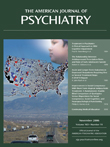Obsessive-Compulsive Disorder: Prevalence, Comorbidity, Impact, and Help-Seeking in the British National Psychiatric Morbidity Survey of 2000
Abstract
Objective: There is little information about obsessive-compulsive disorder in large representative community samples. The authors aimed to establish obsessive-compulsive disorder prevalence and its clinical typology among adults in private households in Great Britain and to obtain generalizable estimates of impairment and help-seeking. Method: Data from the British National Psychiatric Morbidity Survey of 2000, comprising 8,580 individuals, were analyzed using appropriate measurements. The study compared individuals with obsessive-compulsive disorder, individuals with other neurotic disorders, and a non-neurotic comparison group. ICD-10 diagnoses were derived from the Clinical Interview Schedule–Revised. Results: The authors identified 114 individuals (74 women, 40 men) with obsessive-compulsive disorder, with a weighted 1-month prevalence of 1.1%. Most individuals (55%) in the obsessive-compulsive group had obsessions only. Comorbidity occurred in 62% of these individuals, which was significantly greater than the group with other neuroses (10%). Co-occurring neuroses were depressive episode (37%), generalized anxiety disorder (31%), agoraphobia or panic disorder (22%), social phobia (17%), and specific phobia (15%). Alcohol dependence was present in 20% of participants, mainly men, and drug dependence was present in 13%. Obsessive-compulsive disorder, compared with other neurotic disorders, was associated with more marked social and occupational impairment. One-quarter of obsessive-compulsive disorder participants had previously attempted suicide. Individuals with pure and comorbid obsessive-compulsive disorder did not differ according to most indices of impairment, including suicidal behavior, but pure individuals were significantly less likely to have sought help (14% versus 56%). Conclusions: A rare yet severe mental disorder, obsessive-compulsive disorder is an atypical neurosis, of which the public health significance has been underestimated. Unmet need among individuals with pure obsessive-compulsive disorder is a cause for concern, requiring further investigation of barriers to care and interventions to encourage help-seeking.



